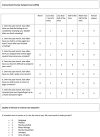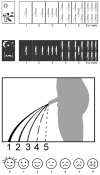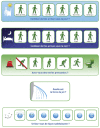How Do Patients Understand Questions about Lower Urinary Tract Symptoms? A Qualitative Study of Problems in Completing Urological Questionnaires
- PMID: 35955002
- PMCID: PMC9368298
- DOI: 10.3390/ijerph19159650
How Do Patients Understand Questions about Lower Urinary Tract Symptoms? A Qualitative Study of Problems in Completing Urological Questionnaires
Abstract
Lower urinary tract symptoms are common complaints in ageing people. For a urological evaluation of such complaints in men, the International Prostate Symptom Score (IPSS) is used worldwide. Previous quantitative studies have revealed serious problems in completing this questionnaire. In order to gain insight into the nature and causes of these problems, we conducted a qualitative study. Not only the purely verbal IPSS was studied but also two alternatives, including pictograms: the Visual Prostate Symptom Score (VPSS) and the Score Visuel Prostatique en Image (SVPI). Men aged 40 years and over with an inadequate level of health literacy (IHL; n = 18) or an adequate level of health literacy (AHL; n = 47) participated. Each participant filled out one of the three questionnaires while thinking aloud. The analysis of their utterances revealed problems in both health literacy groups with form-filling tasks and subtasks for all three questionnaires. Most noticeable were the problems with the IPSS; the terminology and layout of this form led to difficulties. In the VPSS and SVPI, the pictograms sometimes raised problems. As in previous research on form-filling behavior, an overestimation by form designers of form fillers' knowledge and skills seems to be an important explanation for the problems observed.
Keywords: health literacy; lower urinary tract symptoms questionnaires; working-aloud method.
Conflict of interest statement
The authors declare no conflict of interest.
Figures




Similar articles
-
The visual prostate symptom score is a simple tool to identify and follow up in general practice patients with lower urinary tract symptoms associated with benign prostatic hyperplasia (a study with 1359 patients).Presse Med. 2018 Jul-Aug;47(7-8 Pt 1):e91-e98. doi: 10.1016/j.lpm.2018.06.011. Epub 2018 Jul 31. Presse Med. 2018. PMID: 30075950
-
Is new visual prostate symptom score useful as International Prostate Symptom Score in the evaluation of men with lower urinary tract symptoms? A prospective comparison of 2 symptom scores in Turkish society.Urology. 2015 Mar;85(3):653-7. doi: 10.1016/j.urology.2014.10.057. Urology. 2015. PMID: 25733282
-
Comparison of Visual Prostate Symptom Score with the International Prostate Symptom Score and uroflowmetry parameters in assessing men with lower urinary tract symptoms in Dr. Cipto Mangunkusumo National General Hospital, Indonesia.Prostate Int. 2019 Sep;7(3):91-95. doi: 10.1016/j.prnil.2018.09.001. Epub 2018 Sep 25. Prostate Int. 2019. PMID: 31485432 Free PMC article.
-
Comparison of a Visual Prostate Symptom Score and International Prostate Symptom Score: A Prospective Multicenter Study and Literature Review.Urology. 2020 Dec;146:230-235. doi: 10.1016/j.urology.2020.09.001. Epub 2020 Sep 16. Urology. 2020. PMID: 32946910 Review.
-
How international is the International Prostate Symptom Score? A literature review of validated translations of the IPSS, the most widely used self-administered patient questionnaire for male lower urinary tract symptoms.Low Urin Tract Symptoms. 2022 Mar;14(2):92-101. doi: 10.1111/luts.12415. Epub 2021 Nov 3. Low Urin Tract Symptoms. 2022. PMID: 34734477 Review.
Cited by
-
Relationship between interviewer-assisted international prostate symptom score and other objective measures of bladder outlet obstruction in Southeast Nigeria: a cross-sectional study.Pan Afr Med J. 2023 Nov 21;46:87. doi: 10.11604/pamj.2023.46.87.37303. eCollection 2023. Pan Afr Med J. 2023. PMID: 38314235 Free PMC article.
-
Minimally Invasive Treatment in Benign Prostatic Hyperplasia (BPH).Technol Cancer Res Treat. 2023 Jan-Dec;22:15330338231155000. doi: 10.1177/15330338231155000. Technol Cancer Res Treat. 2023. PMID: 36794408 Free PMC article.
-
Developing questions to assess and measure patients' perceived survival benefit from adjuvant endocrine therapy in breast cancer: a mixed methods pilot study.Clin Exp Med. 2024 Feb 14;24(1):36. doi: 10.1007/s10238-023-01261-4. Clin Exp Med. 2024. PMID: 38353722 Free PMC article.
References
-
- European Association of Urology Guideline Management of Non-Neurogenic Male LUTS 2022. [(accessed on 20 May 2022)]. Available online: https://uroweb.org/guidelines/management-of-non-neurogenic-male-luts.
-
- American Urological Association Guideline Management of Benign Prostatic Hyperplasia/Lower Urinary Tract Symptoms 2021. [(accessed on 20 May 2022)]. Available online: https://www.auanet.org/guidelines/guidelines/benign-prostatic-hyperplasi....
MeSH terms
LinkOut - more resources
Full Text Sources
Medical
Research Materials

